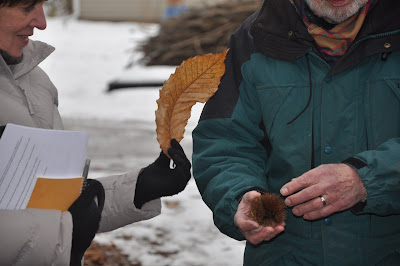With the temps in the 50s these last two days, we knew that sugaring season was here. That, plus the fact that the month of March is when The Dahlem Center does it's maple sugaring programs for school groups. So, with eager anticipation, today was the annual training o' the volunteers.
Volunteers are vital to the successful operation of our maple sugaring program. Several stations are set up around the property, each highlighting a portion of the history of sugaring, the collection of sap, or the conversion of sap into liquid gold.
After an animated discussion inside of the different stations and a demonstration of all the various props we use, Carrie led the group (27 strong) out to the sugar bush.
Da Boyz had preceded us and set the buckets out.
Using the good old-fashioned hand drill (I love these tools!), holes are drilled, slightly upwards, about two inches into the trunk of the tree.
The spile is hammered in and the bucket hung.
A cover is placed over the top to keep the deer from snacking too much, and to keep the majority of the rain and snow from diluting the precious sap.
We also demonstrate the use of plastic bags in lieu of buckets, as well as the ever popular tubing, which pipes the sap directly to large holding containers.
At the sugar shack, one wants to have a good supply of wood on hand to feed the voracious fire that heats the evaporator, which magically transforms the watery sap into thick, sticky, sweet syrup.
Our evaporator is a small unit, so it doesn't need anywhere near as much wood as the big commercial operations do.
It takes about 40 gallons of sap to make one gallon of syrup. If you are using sugar maple, that is. If you tap Norway maples (which, by the way, are an invasive species, and even though they make a pretty decent syrup, they are invasives and should be cut down), you will need closer to 60 gallons of sap - the sap has a much lower sugar content than that of the sugar maple.
One should always have ones eyes open, however, for whatever other goodies nature may bring your way...even if you are in a training workshop.
One of our volunteers brought me this cocoon, plucked from the wall of the sugar shack.
The maker of the cocoon never pupated, though. When I turned it over, its dessicated carcass lay all stiff and dry inside. Pupae actually need a fair bit of humidity in order to survive. Either the humidity was wrong, or something else got to this larva before it had a chance to change. If there are any moth experts out there, I'd love an opinion as to which species this might be.
A truly wonderful find, however, was what you see below: the seed husk in Paul's hand, the leaf in Libby's.
Yes, Virginia, it is an American Chestnut! A real, genuine American Chestnut! We have this one specimen that popped up and a couple years ago they found these nut husks on the ground - a rare occurrence these days. Gary said that the tree didn't produce any nuts this last fall, so these husks (we found two) must've been from 2009. The nuts are long gone, but the very prickly husks remain. I brought this one inside to add to our collection of goodies to share with the public.
So, if you are in the Jackson area, you might want to keep yourself available next month to come out to our Maple Sugar Festival on Saturday, 19 March. Although most of the month we do our sugaring program just for school groups, we do set this one afternoon aside so families and folks without families can come and learn how maple syrup is made. And who knows...maybe you'll get a chance to see an American chestnut, too.











Very nice article. Clear and concise information on maple sugaring. I know the kids would love to come ... but it's a bit of a drive for us! Neat chestnut!
ReplyDeleteWow, I didn't think American Chestnuts survived long enough to produce nuts. That's fabulous!
ReplyDeleteMaple Sugaring was a popular school trip when my kids were growing up and they attended a number of demonstrations. One year, they invented their own equipment and tapped our trees and made maple syrup on the stove by themselves.